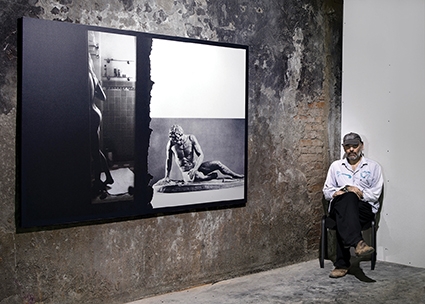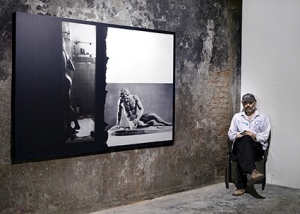Interview with Vakho Bughadze
Georgia Today continues a series of interviews with Georgian artists together with BI Auction for Art. In this issue, we introduce Vakho Bugadze, a painter and sculptor who experiments and uses different methods to express himself through his art. Bugadze graduated from Tbilisi State Academy of Arts in 1991, gaining acclaim as one of the most talented artists of his generation. His works have been showcased at various personal and group exhibitions both in Georgia and abroad throughout his career as an artist.
We met Vakho Bugadze at his studio to talk about his art, inspiration and creativity.
What were the factors that made you become an artist?
As I remember, I was in the fourth or fifth grade at school when my Russian language teacher invited me to participate in a sculpting competition which I won and they took me to art school, where I studied sculpture. So, when I decided to enter the Tbilisi State Academy of Arts I wanted to pursue my studies in sculpture again, but I only got in the Academy for the second year and studied applied arts. I served two years in the army and only when I came back was I able to finally change to sculpture, graduating in 1991. The 90s were a chaotic time. Two of my friends, Lado Gorgadze and Zaza Lejava, and I found ourselves at the Silk Factory, which was on the Academy balance, so we had our first artists’ studios there. The Silk Factory soon became a place where not only painters, but musicians, met, held rock concerts, performances, and exhibitions- in many ways it became a center of an underground culture in the city of the 1990s.That lasted almost four years and that’s where I started painting and had exhibitions.
It’s difficult to say what started me painting, and I think there are number of factors that define us. Sometimes you may know what you want to do as early as your childhood, or on the contrary, there are lots of young people who struggle to decide what they want to pursue as a profession, and their parents try to encourage them. I think it’s important to follow your way, although it may be challenging, and artists of my generation had reasons enough to choose a different path, considering the time we lived in.
Where do you find inspiration?
It’s always different and consists of so many things. It may be searching for something, the process from which your work, your art comes to life, or it may be a different inspiration, an impulse each day. In my case, especially with the last few exhibitions, they were all thematic, so if that could be called an inspiration, it turned out that I was thinking about a certain theme, not so much searching, but rather discovering it in me. That was the actual dynamic. You have to decide how it’ll look, which material you will use, what size the works will be and details like that. One of my exhibitions, Hippodrome, was inspired by a true story, when in the early 90s, together with my friends, I bought a horse, and we were regularly going to hippodrome, uniting many people around us, who shared the same interests, all from the same generation. That story, from almost 20-22 years ago inspired a whole exhibition in 2013. The last exhibition, held just last month in the Literature Museum in Tbilisi, was on the theme of boats and piers and docks, something I remember from my childhood, and yet another one called Suburb that came from my memory of relocating from the center of Tbilisi, where I lived with my grandparents, to the city suburbs in Gldani, that was just being built and had just two or three blocks. So, if we’re talking about inspirations, all of these are. Memories in general for me are related to the art of painting.
To what extent have you transformed as an artist?
I would say it’s a process of discovery and pleasure. Of course, in different periods you yourself may have different types of energy and vibes that change; your works change as long as a person changes through different stages and ages in life. It transforms, turns into a different form, but there’s no fatigue in it. You don’t get calmer with age, not at all. It’s difficult to explain, I think in painting, not everything is explainable.
What do you want to express through your works?
Lots of things, so many things actually: it’s a unity of numerous components, but for me painting is something that stays with you forever. Not necessarily my own work, someone else’s, too. It doesn’t matter which paintings you admire, you can be fond of the very first works of art on the cave walls, for example. Something moves you, and it’s a whole universe that can be found in one painting. For me, Deer Hunting by Lucas Cranach is the one, a key to understanding the universe. It depends what’s important for you. In Deer Hunting, I can see the whole substance of our living.
Creation is a continuous process, and the most important part is to take pleasure from it. Even if I have a certain concept while I work, it doesn’t mean I know for sure what the end result will be. I may know I’m painting a house, what I don’t know is how it will end up looking. It’s almost on the level of sensations, especially with abstractions, which are the most difficult to work on, because in reality you’re trying to paint something that doesn’t exist and it’s on your craft what will come out of it.
Are exhibitions important for you, and are you usually satisfied once they are over?
I think exhibitions are a necessity as you work, and new paintings are being created that you have to exhibit, because it’s often difficult to collect all the works afterwards in one place: some can be even lost. At the end, I’m satisfied if the way I visualized the exhibition is the same as it’s done.
What do you think needs to be done to promote Georgian painters more?
Lack of exhibition spaces and galleries is certainly a huge problem, especially big spaces for larger exhibitions. There must be more people supporting young artists. I just saw at the Venetian Biennale, where my students are attending and posting photos from, the works of Damien Hirst. Just imagine how many people are working to make it happen- it’s amazing. We’re not in a stagnation, we’re lacking people to assist and collaborate with artists. We need such people because then new ideas will be born.
Nino Gugunishvili











